BeforeSwine
New Member
- Joined
- Sep 18, 2017
- Messages
- 3
Howdy Pearl-people! I could sure use a bit of your knowledge.. but first... the questions at hand:
1. Do the pearls feel slightly gritty or smooth when rubbed gently against another pearl (or against the edge of your tooth, if there is only one pearl?) Please rub gently!
If they are gritty, they are likely to be real nacre (genuine pearls.) If they feel smooth, they are likely imitation pearls.
TRUE GRIT
2. Please provide clear, in-focus photos without flash against a white background (a paper towel works nicely.)
Include close-ups of the clasp (front and back) and a few of the pearls. If there are flaws, include a photo of those. Also the box they came in, and tags if you have them.
PHOTOS FOLLOW, BACK OF CLASP IS BLANK
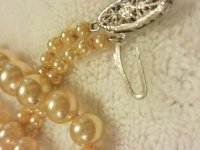
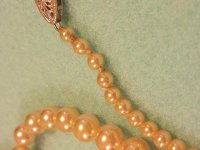
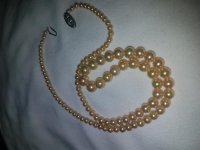
3. Any history you can give us about the pearls. Where/when you or your relative got them, any documentation you have (receipts, appraisals), their price range if you know it, etc.
Inherited these when my mother passed. Out of a box of glass and plastic faux, these were the treasure. They had belonged to my Great-Grandmother, which I believe puts them out of age-range for cultured? So far my guess is South Sea champagne.. really need help with maker ID and other leads into how to value... opinions wanted!
Heres a shot of UV luminescence. From bottom moving clockwise: glass, these, and plastic
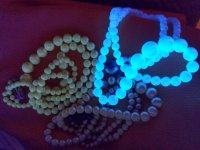
4. Describe any marks on the clasp. These may be numbers (14K, 585, 750, 925 etc.) or brand names or even pictures. If the clasp has stones, have you had them tested, or do you have documentation about what they are?
14k white gold clasp with an "S"? mark and an arrow through a circle hallmark of some sort.

5. Measure the pearls, with a millimeter ruler if possible. If they are graduated, measure the largest and smallest pearls.
About 2.6mm small end to 7mm center. I thought maybe the knots at the ends may be an indication of maker?

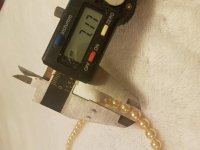
apologies for the sideways photos!
1. Do the pearls feel slightly gritty or smooth when rubbed gently against another pearl (or against the edge of your tooth, if there is only one pearl?) Please rub gently!
If they are gritty, they are likely to be real nacre (genuine pearls.) If they feel smooth, they are likely imitation pearls.
TRUE GRIT
2. Please provide clear, in-focus photos without flash against a white background (a paper towel works nicely.)
Include close-ups of the clasp (front and back) and a few of the pearls. If there are flaws, include a photo of those. Also the box they came in, and tags if you have them.
PHOTOS FOLLOW, BACK OF CLASP IS BLANK



3. Any history you can give us about the pearls. Where/when you or your relative got them, any documentation you have (receipts, appraisals), their price range if you know it, etc.
Inherited these when my mother passed. Out of a box of glass and plastic faux, these were the treasure. They had belonged to my Great-Grandmother, which I believe puts them out of age-range for cultured? So far my guess is South Sea champagne.. really need help with maker ID and other leads into how to value... opinions wanted!
Heres a shot of UV luminescence. From bottom moving clockwise: glass, these, and plastic

4. Describe any marks on the clasp. These may be numbers (14K, 585, 750, 925 etc.) or brand names or even pictures. If the clasp has stones, have you had them tested, or do you have documentation about what they are?
14k white gold clasp with an "S"? mark and an arrow through a circle hallmark of some sort.

5. Measure the pearls, with a millimeter ruler if possible. If they are graduated, measure the largest and smallest pearls.
About 2.6mm small end to 7mm center. I thought maybe the knots at the ends may be an indication of maker?


apologies for the sideways photos!
